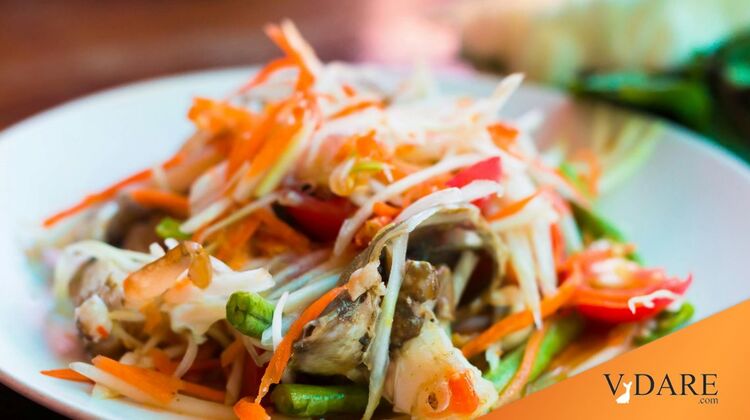
The Restaurant Rationale For Immigration — And Gastrodiplomacy
02/03/2024
I liked Thai restaurants from the first time I went to one in 1983 because I have childish taste buds and the semi-sweet food appealed to them.
Way back in 2002, I wrote in VDARE:
Steve Sailer
04/17/2002Ethnic restaurants are the Holy Grail of justifications for not reforming our immigration system. The most powerful people in the country go out to lunch a lot more than the average citizen. This influences their views on immigration to an intellectually embarrassing extent.
In fact, of course, mass immigration is not necessary for outstanding ethnic restaurants. For decades, the gold standard for cuisine was the French restaurant. Yet few French ever immigrated.
When I was a kid, the typical Italian restaurant had a name like “Luigi’s Spaghetti Shack” and a menu with a heavy emphasis on garlic bread and meatballs. Today, Italian restaurants have names like “Trattoria Firenze,” and I can’t make head or tail of their menu items, such as “Strawberries with Ricotta in Balsamic Reduction,” but it’s exquisite. Yet this vast improvement took place with minimal immigration.
How? First, a large percentage of those few who did come here from Italy or France came specifically because they had outstanding cooking skills. Second, the lack of mass immigration from those countries provided room for innovative American acolytes, such as the great Alice Waters of Berkeley’s Chez Panisse or Chicago’s brilliant Charlie Trotter.
In contrast, much as I like Thai restaurants, I haven’t seen much evidence that they’ve improved in the last two decades. Thai restaurants in the U.S. are not typically being opened by people who immigrated here to spread the glories of Thai cuisine. The owner is usually somebody’s brother-in-law who got into the U.S. on a family unification visa. Lots of relatives and friends here run Thai restaurants, so the new immigrant got into the same line of work. The abundance of immigrant-run Thai restaurants does keep prices low. Unfortunately, that precludes ambitious American chefs from getting into the Thai restaurant business.
Interestingly, that same year the Thai government formalized my insight by subsidizing and standardizing immigrant restaurants.
From a Food & Wine article on “Why Are There So Many Thai Restaurants?”
You Think You Understand Thai Culture Because You Eat at Thai Restaurants? Think Again
A government campaign drove the popularity and similarity of Thai menus, but they left out an ingredient: the experiences of actual Thai people.
By Alexandra Domrongchai Published on February 1, 2023
Growing up in the American South, I was usually the only Thai person in any room. I’m used to seeing the limited knowledge that many Americans have about Thai culture, often reducing it to a takeout order or an object of fetishization. As a Thai American person, I find myself thinking a lot about my own experiences, as well as my family’s of being Thai restaurant owners, and I come back to this quote by scholar Jennifer Ho: “I understood my identity through my family and foodways.”
Food has played a significant role in the ways people perceive my family’s identity in America. Witnessing members of my family being expected to fulfill a role of being easy-going (Thailand is marketed as “The Land of Smiles”) and serving delicious food compels me to explore the origins of this concept of “Thainess.” That’s the performance that Thai people do to uphold ideas of Thai culture and cuisine that have nothing to do with the actual experiences of Thai people.
But how did there get to be so many Thai restaurants in America, with diners having such limited knowledge of actual Thai people? Gastrodiplomacy.
Gastrodiplomacy, also known as culinary diplomacy, involves a country using food as a means of globalizing and gaining international influence. This was something Thailand was particularly skilled at. In 2002, the Thai government launched the Global Thai Program, a diplomatic initiative with the aim of increasing the number of Thai restaurants worldwide. The state provided training programs, grants, and information to Thai investors who wanted to open restaurants abroad. As part of this campaign, Pad Thai — a dish with virtually no cultural history — was positioned as Thailand’s national dish and pioneered a culinary campaign funded by the Thai government with 500 million baht ($15 million USD). The government believed that the project would contribute to agricultural and food exports, while also producing foreign income from overseas transactions of goods and services. It worked. Thailand’s cuisine has become a global phenomenon as a result of the project.
It was already a big deal in the U.S. I first went to a Thai restaurant in 1983, which is why I could note in 2002 that nothing much was progressing.
By 2011, the global number of Thai restaurants had increased to more than 10,000 and the nation positioned itself as the “kitchen to the world” by advancing the exceptional quality of Thai food around the globe and becoming a food capital for the world. It also laid out strict standards for what diners can expect on menus. Thailand’s Department of Export Promotion designed prototypes for three different styles of Thai restaurants: Elephant Jump for fast food, Cool Basil for mid-priced casual cuisine, and Golden Leaf for high-end meals. Thai restaurants abroad can be awarded the Thai Select award by the Thai government, as long as their restaurants abide by the government’s standards. To be considered authentic and high quality, these restaurants abroad must meet certain criteria during inspections, including being open for at least five days a week, employing government-trained Thai chefs, and using Thai products. These standards may ensure the quality of the restaurants, but also contribute to a standardization of Thai food and by extension, perceptions of Thai people.
